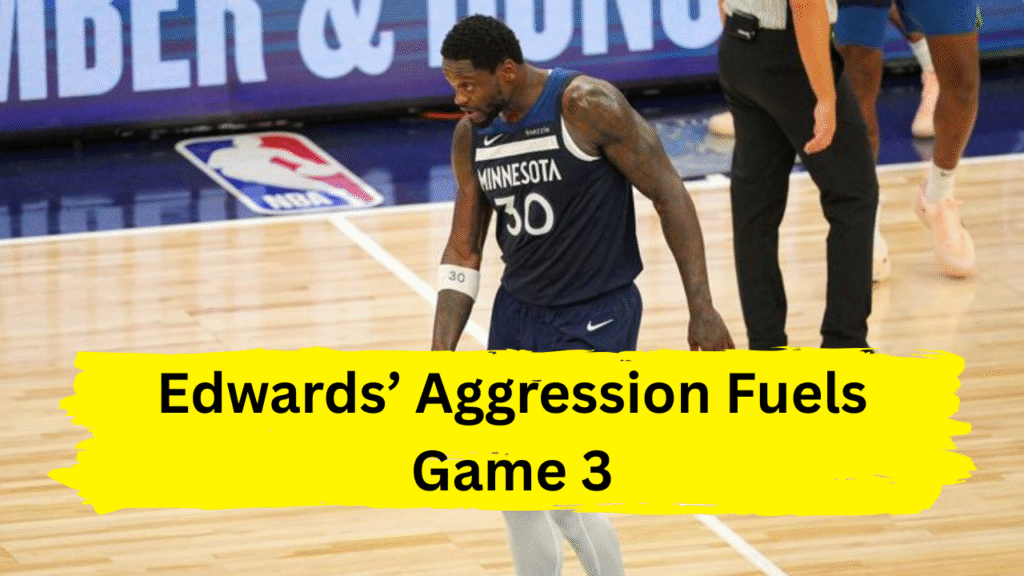The Minnesota Timberwolves’ 143-101 demolition of the Oklahoma City Thunder in Game 3 of the Western Conference Finals wasn’t just a victory—it was a statement. After trailing 0-2 in the series, the Wolves unleashed a performance that blended ferocity, precision, and sheer star power, headlined by Anthony Edwards’ electrifying 30-point masterclass. The win not only breathed life into Minnesota’s playoff hopes but also revealed the blueprint behind their resurgence: Edwards’ relentless aggression and clutch shooting, paired with tactical adjustments that exposed OKC’s vulnerabilities.
Edwards Sets the Tone: Aggression Meets Efficiency
From the opening tip, Anthony Edwards played like a man possessed. He dropped 16 points in the first quarter alone, outscoring the entire Thunder team (14 points) and setting a tone of dominance that reverberated through Target Center. His 12-of-17 shooting (70.6% FG), including 5-of-8 from three-point range, showcased a lethal blend of confidence and precision—a stark contrast to his 1-of-9 three-point struggle in Game 2 .
Edwards’ aggression wasn’t limited to scoring. He attacked the rim with purpose, hunted transition opportunities, and even chased loose balls like his career depended on it. Two breakaway dunks off steals epitomized his intensity, turning defensive hustle into highlight-reel offense. As Thunder coach Mark Daigneault admitted, Minnesota’s “force on both ends” overwhelmed OKC’s typically stout defense .
Clutch Shooting: Trusting the Moment
Edwards’ growth as a closer has been a recurring theme in these playoffs. While the Timberwolves struggled in clutch situations during the regular season (ranking 20th in offensive efficiency in close games), Edwards has flipped the script when it matters most . In Game 3, his decisiveness in critical moments dismantled OKC’s defense. Whether stepping back for a three-pointer or driving past defenders for acrobatic finishes, he balanced individual brilliance with smart playmaking, tallying six assists and trusting teammates like Terrence Shannon Jr. (15 points off the bench) to capitalize on openings .
This maturity marks a departure from earlier in his career, where Edwards occasionally defaulted to isolation-heavy “hero ball.” Now, he reads double-teams with poise, leveraging his gravity to create opportunities for others. As coach Chris Finch noted, “When [Edwards] plays like this, it takes us to another level” .
Tactical Adjustments: Neutralizing OKC’s MVP
Minnesota’s defensive strategy also played a pivotal role. The Wolves stifled newly crowned MVP Shai Gilgeous-Alexander, holding him to a season-low 14 points on 4-of-13 shooting. By dropping defenders back and avoiding fouls—a stark contrast to Games 1 and 2—they disrupted his rhythm. Jaden McDaniels and Rudy Gobert anchored this effort, with Gobert’s rim protection forcing SGA into contested mid-range attempts. The crowd amplified this pressure, taunting Gilgeous-Alexander with chants of “Free throw merchant!” as his free-throw attempts plummeted from 14.5 per game earlier in the series to just four .
Offensively, Minnesota exploited OKC’s defensive switches. Edwards adjusted his pick-and-roll angles, creating split-second advantages to either attack the rim or launch pull-up threes. Julius Randle, rebounding from a benched Game 2, added 24 points, capitalizing on mismatches in the post. The Wolves’ 57.3% field goal efficiency and 50% three-point shooting underscored their offensive fluidity .
The Ripple Effect: Bench Depth and Home-Court Energy
While Edwards starred, Minnesota’s depth sealed the win. Rookie Terrence Shannon Jr. erupted for 15 points in 13 minutes, outscoring every Thunder reserve. Naz Reid and Nickeil Alexander-Walker provided additional sparks, combining for 26 points and stretching OKC’s defense. This collective effort—45 bench points to OKC’s 26—highlighted the Wolves’ superior roster construction .
The Target Center crowd further fueled the fire. Edwards admitted he “couldn’t hear plays being called” due to the deafening roar, a testament to the home-court advantage that has seen Minnesota go 6-1 at home this postseason .
Looking Ahead: Sustaining Momentum
While the Wolves’ Game 3 dominance was historic—setting a franchise playoff scoring record and handing OKC its worst loss of the season—the series remains precarious at 2-1. Edwards emphasized this postgame: “We’re still down 2-1. No victory laps” . For Minnesota to complete the comeback, replicating Edwards’ aggression and defensive discipline will be key.
The Thunder, meanwhile, face existential questions. Can Gilgeous-Alexander rediscover his rhythm? Can their role players step up? History isn’t on their side: no team has ever won a title after suffering a 40-point playoff loss .
Conclusion
Minnesota’s Game 3 triumph was more than a bounce-back—it was a revelation. Anthony Edwards, with his blend of raw talent and refined decision-making, has emerged as the catalyst for a team capable of toppling giants. His aggressive playstyle and clutch shooting, amplified by tactical ingenuity and team-wide buy-in, have reignited the Wolves’ championship aspirations. As the series shifts to Game 4, one truth is undeniable: when Edwards shines this brightly, Minnesota becomes a force few can contain.


